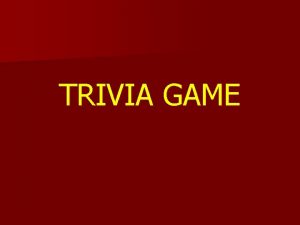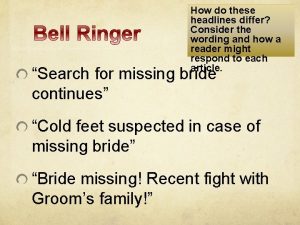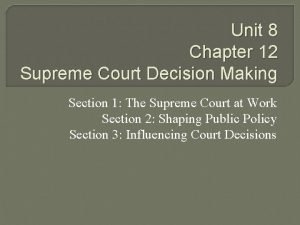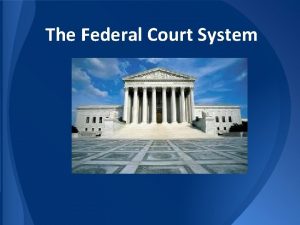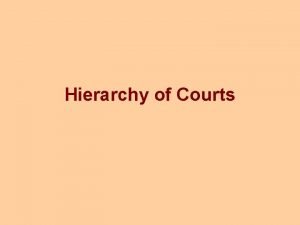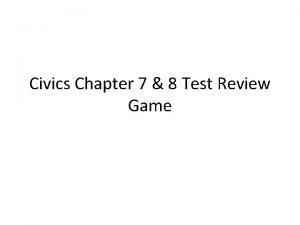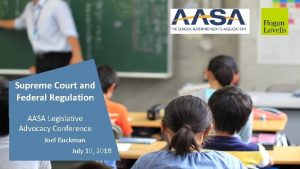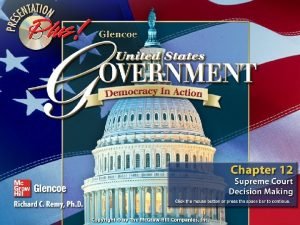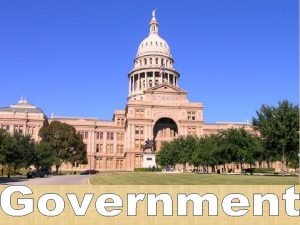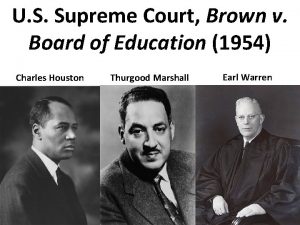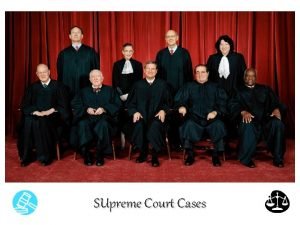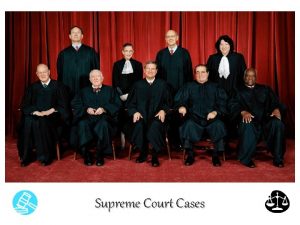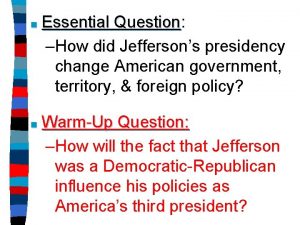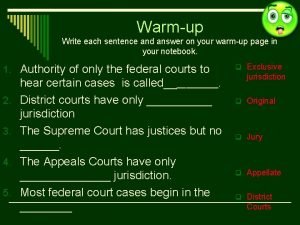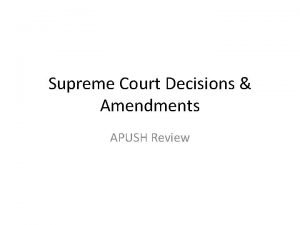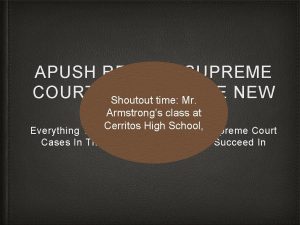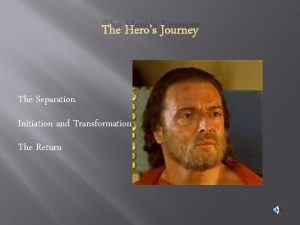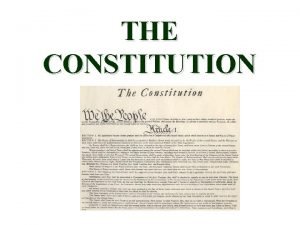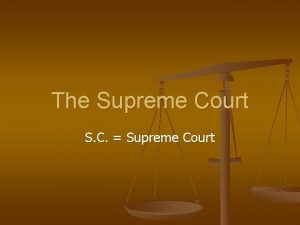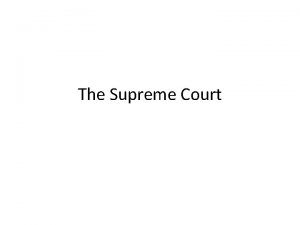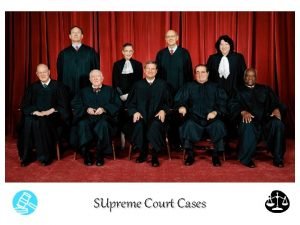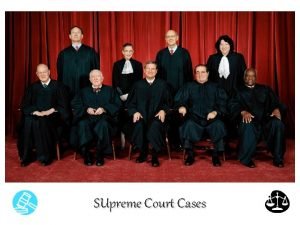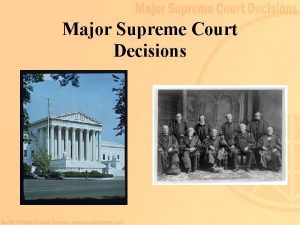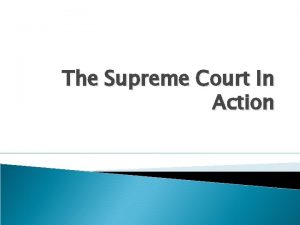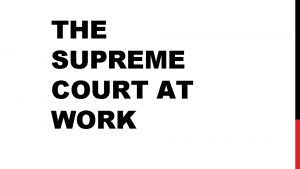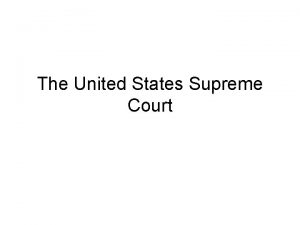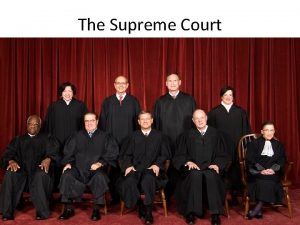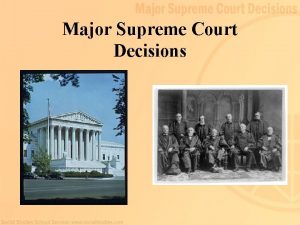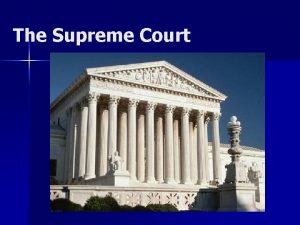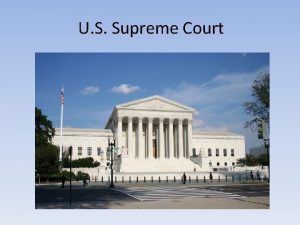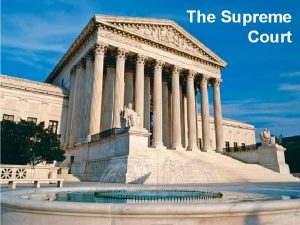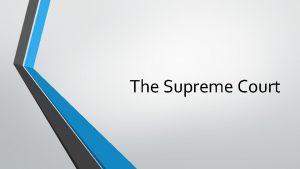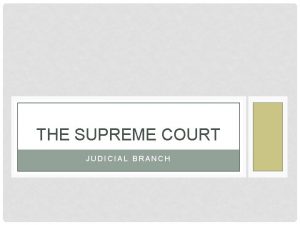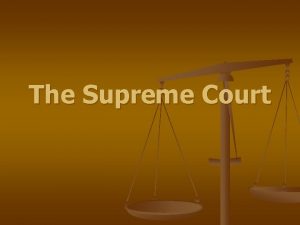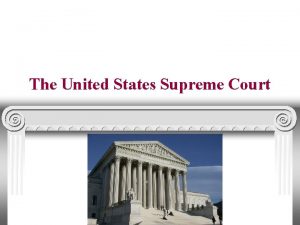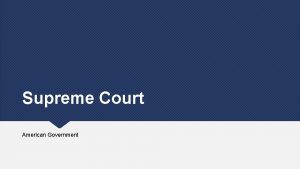The Supreme Court Unit 4 Institutions The Supreme




















![B. Conservatives 1. John Roberts (Bush 43, 2005 - 63) [current Chief Justice] 2. B. Conservatives 1. John Roberts (Bush 43, 2005 - 63) [current Chief Justice] 2.](https://slidetodoc.com/presentation_image_h2/43e6f13ec173ad93fc4351ecb9b7221b/image-21.jpg)


- Slides: 23

The Supreme Court Unit 4: Institutions

The Supreme Court in Action… To help you contextualize what the court does and how influential they are on our daily lives… The Supreme Court Landmark Rulings

I. Background Only court mentioned in Const (Article III) B. Consists of 8 Associate Justices and 1 Chief Justice C. Highest court in the land- the court of last resort A.

I. Background Cond D. Terms �Not elected �Appointed by president- confirmed by Senate �Serve for life �Since they are not elected- insulated (kept out) from public opinion

E. Key powers 1. Power of judicial review (est. by Marbury v. Madison, 1803) 2. Power to interpret broadly worded laws of Congress and the Constitution 3. Power to overrule earlier Supreme Court decisions (i. e. Brown v. Board overturning Plessy v. Ferguson)

II. Jurisdiction A. Original: in cases involving 1. States 2. Ambassadors B. Appellate: in cases from 1. Courts of Appeals 2. State Supreme Courts

III. How cases reach the Supreme Court By Request B. Rule of Four: In order for the Court to decide a case, 4 justices must agree to do so. Denying a decision may mean any number of things: A. 1. 2. 3. 4. Case lacks a substantial federal issue Party lacks standing Court agrees w/ lower court Case is a “political hot potato” that the Court does not want to touch- i. e. Gay Marriage #loveislove

C. Writ of certiorari (“to be made certain”). D. Acceptance of cases

Visual for How Cases Move Up State Route Federal

IV. The Supreme Court at work

Term begins on first Monday in October and continues until the end of June B. Hears cases from Monday- Thursday Quorum (minimum) of 6. C. Briefs D. Justices also read amicus curiae (“friend of the courts”) briefs A.

Justices hear 30 min oral arguments from each side F. At the Friday conference, Justices discuss the cases G. Simple majority needed for decision. In case of ties, previous court decision stands (Stare Decisis- Let the Decision Stand) E.

H. Opinions of the Court Since there are 9 justices- that means potential for 9 different interpretationsthere is need to have legal rationale for their interpretations- so the justices write down these opinions/interpretations-here is an example: Supreme Court Opinions

H. Written opinions: 1. Types: a) Unanimous: (9 -0) b) Majority: Example-(6 -3) c) Dissenting: Disagree with majority d) Concurring: Agree with majority for different reasons

2. Purposes of opinions a) Communication b) Precedents c) “In the absence of any action by Congress…”

V. Possibility of evading Court decisions (i. e. Checks & Balances)

Amending the Const. The Court cannot strike down something as unconstitutional if it is not in the Constitution! B. “Remanding”- Return a case to a lower court for reconsideration C. The executive branch may simply not carry out the decision (i. e. Jackson’s famous line: John Marshall has made his decision. Now let him carry it out”) A.

State and local governments may simply not carry out either (i. e. desegregation, school prayer) E. “The Constitution may be what the Supreme Court says it is, but a Supreme Court opinion is what a trial judge or a policeman, or a school board or a city council says it is” D.

Visual for this process…

VI. Voting blocks on the current Supreme Court A. Liberals 1. Elena Kagan (Obama, 2010 - 57) 2. Sonia Sotomayor (Obama, 2009 - 63) 3. Ruth Bader Ginsburg (Clinton, 199385) 4. Stephen Breyer (Clinton, 1994 - 79)
![B Conservatives 1 John Roberts Bush 43 2005 63 current Chief Justice 2 B. Conservatives 1. John Roberts (Bush 43, 2005 - 63) [current Chief Justice] 2.](https://slidetodoc.com/presentation_image_h2/43e6f13ec173ad93fc4351ecb9b7221b/image-21.jpg)
B. Conservatives 1. John Roberts (Bush 43, 2005 - 63) [current Chief Justice] 2. Clarence Thomas (Bush 41, 199167) 3. Samuel Alito (Bush 43, 2006 - 68) 4. Neil Gorsuch (Trump, 2017 - 50)

C. Swing/Moderate conservative 1. Anthony Kennedy (Reagan, 198781)

Lecture DQs Identify judicial review and discuss 2 ways the Supreme Court can exert this power 2. Discuss the process of how a case reaches the Supreme Court 3. Explain the politics of opinion writing 1. ² Bonus: How is the Supreme Court “insulated” (protected) from public opinion? Explain
 Is there a basketball court above the supreme court
Is there a basketball court above the supreme court What do these headlines say about how the supreme court
What do these headlines say about how the supreme court Vocabulary activity 12 supreme court decision making
Vocabulary activity 12 supreme court decision making Supreme court justice system
Supreme court justice system Political parties
Political parties Jurisdiction of high court
Jurisdiction of high court The u.s. supreme court works chiefly as a(n)
The u.s. supreme court works chiefly as a(n) Supreme court does
Supreme court does Supreme court does
Supreme court does Have supreme court
Have supreme court The supreme court
The supreme court Supreme court
Supreme court Supreme court
Supreme court Insular cases apush
Insular cases apush Supreme court cases graphic organizer answers
Supreme court cases graphic organizer answers Which precedent was established by marbury v. madison
Which precedent was established by marbury v. madison John marshall
John marshall John marshall supreme court
John marshall supreme court How cases reach the supreme court worksheet answers
How cases reach the supreme court worksheet answers Important amendments apush
Important amendments apush Schechter poultry v us apush
Schechter poultry v us apush Unit 6 review questions
Unit 6 review questions What is the supreme ordeal in the odyssey
What is the supreme ordeal in the odyssey Supreme law of the land clipart
Supreme law of the land clipart
